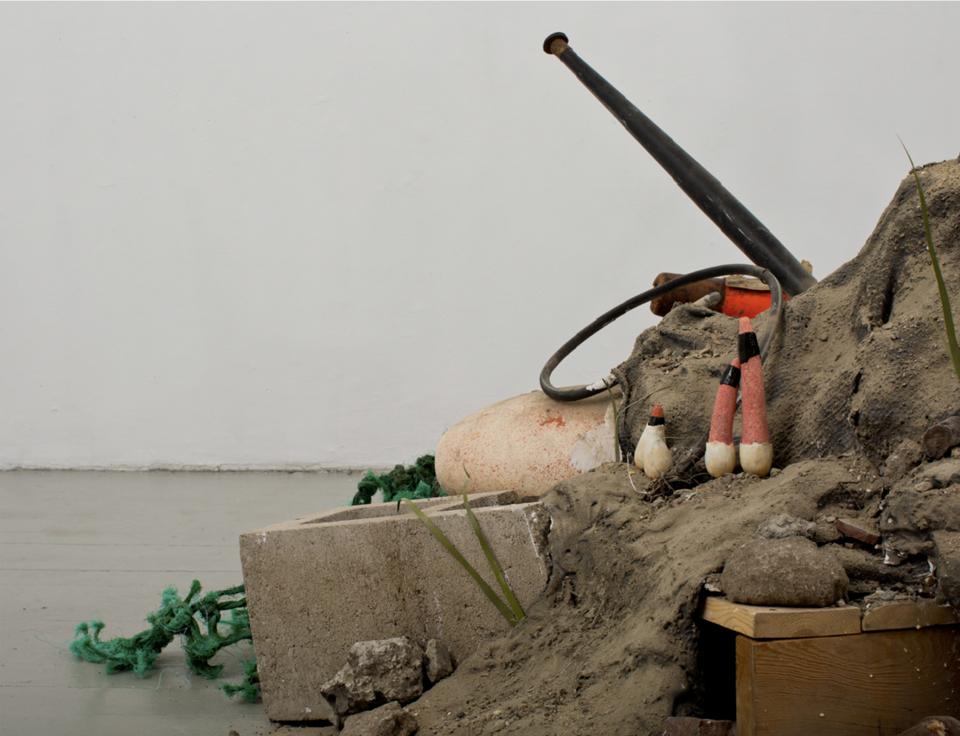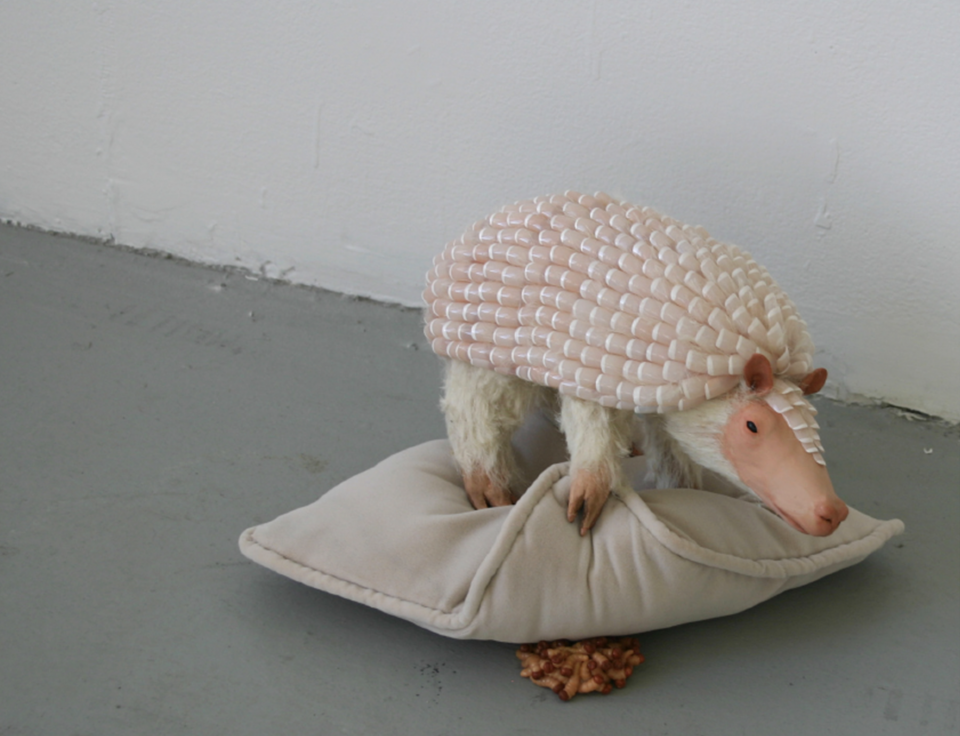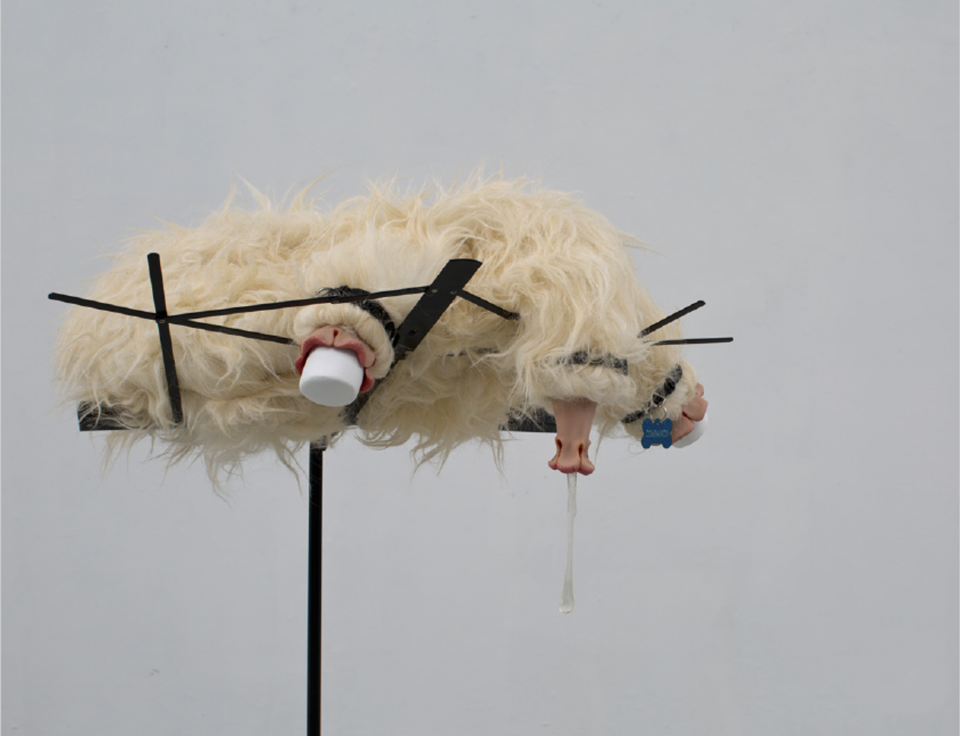Raina Belleau
Nature Faker
Theodore Roosevelt objected to the work of novelists like Jack London, author of Call of the Wild, because of the way nature was romanticized in their stories. Roosevelt called these writers “Nature Fakers”. As someone who recreates animal and natural forms with artificial materials I am literally faking nature, but I am also using it as a way to create narratives about our relationship with nature. The romanticizing of nature is problematic but it has created strange new narratives that are otherworldly and often as disturbing as they are idealistic. These other worlds can be post-apocalyptic, absurd, grotesque, or romantic, and can spill over into our own world when we least expect. Through my sculptures and videos I create and expose the places where nature, fiction, science and art collide with each other and what happens at this intersection.
Under the surface of this world there are others, pressing up against one another like soap bubbles. These other worlds ooze into our own. There is seepage, slippage and spillover, both accidental and aggressive. The friction that is created by two worlds bumping against each other creates uncanny images and ideas that exist in between them.
In David Lynch’s television series, Twin Peaks, there is a parallel world called the Black Lodge. In this place people speak backward and take on the appearance of others. They are prophetic protectors and shape-shifting attackers. The entrance to this other and ancient world is in the woods in a stagnant pool of water, and seeps into and stains the lives of contemporary Americans in the town of Twin Peaks.
The forest that surrounds the town is a refuge for criminals, predators, recluses, and others looking for an escape of one form or another. The power that rises to the surface and is felt in our familiar world can be attributed to aliens, black magic and ancient mysticism, but whatever it is, it is understood to be other. The forest is the environment that helps create this sense of estrangement and gives shelter to the unknown. That there is a source of evil existing in nature is an idea that we have grown to accept and almost expect.
When the familiar and the unfamiliar make contact it is uncanny. One world touches another, generating osmosis between images and ideas. My sculpture and video work are incrementally building another world that makes contact with ours and reflects it. The friction created by this fabricated world with our own is humorous, dark, sometimes violent, sometimes sexual and often unsettling. This other world pokes and prods at the culture we have built around nature. My world reflects our own, presenting a backward image, familiar yet strange.
In my world there is a scout and a ranger and both characters have my face. One has authority over the other, while the other is submissive and ever trusting. I look up into my own eyes and except the marshmallows that I force into my mouth. In another scene the neckerchief clasp of the scout stares back at you as the camera shifts focus between it and the burning marshmallow. Not even the roasting of the marshmallow can be trusted because in the world I have created the marshmallow melts, drips, shrivels and billows black smoke. Throughout this video there is a shifting, of focus, of authority and of identity. The place and activities are familiar but skewed. These unsettling qualities are created because of the contradictory familiarity and strangeness of the images presented.
Other works, like the video “Bonded Pairs” generate disruptions by depicting something familiar in a shifting light. In this two channel video installation, the exotic birds shriek and their mannerism and body language are alien, sometimes monstrous, sometimes pathetic, but contradictory to the way they are perceived by those who might desire them as pets. These birds suffer from social disorders brought on by captivity and human neglect. The second video is an attempt to heal this psychological damage and the mirroring and transparency gives the birds a social partner to become bonded to.
Within the sculpture other worlds are created by distorting existing space or creating new space. Exaggerations such as “Wretch,” a coyote suspended thirteen feet in the air by a column of vomit, a porcupine mascot for some unknown organization, a domestic space interrupted by the messy reality of nature in “Stilted and Precious”—these sculptures create an idea of place, but make it one that is a step removed from our own. It is one with a different gravity, or a secret organization, or the home of an over enthusiastic animal lover. These places are familiar but uncomfortable.
Recently the world I am constructing is becoming more like our own, but set in a potential near future. It is a future of crumbling infrastructure where nature, the weeds, fungus, and beasts creep in from the no-man’s land that borders cities, suburbs, freeways, from the strips of grass, gravel and stunted trees that line the neglected places where urbanism peters off. These landscapes sit between abandonment and disaster.
It is grotesque to admit defeat, or to even acknowledge that we are living off the carcass of a planet we have killed. Like ticks feeding off the body of an animal we have drained it of blood. But it is also invigorating to know we are still here at the end of the world, even if the encore is an unwelcome barrage of blizzards, hurricanes, extended droughts and rising sea levels. It feels like the end of the 1968 film Planet of the Apes, when Charlton Heston discovers the Statue of Liberty buried in the sands of what he had thought to be an alien planet.
This image of a species and a planet brought into ruin by ignorance and inaction is predicted by environmental and aesthetic philosopher Timothy Morton. Morton takes the bold stance in his books that the end of the world began with the invention of the internal combustion engine because it gave humans the ability to vastly change the composition of our atmosphere and accelerate global warming, the true cause of the apocalypse, at an unprecedented rate. By this theory, we are currently experiencing the slow and steady end of the world. He also argues that the tipping point for effective action against global warming has also long since past.3 Somehow this is a reassuring thought. We can stop worrying about fixing problems and start adapting and learning to slow the effects of global warning rather than stopping it, which is now a moot point. This also means that perhaps we don’t need to look over our shoulder to look for potential predators, but to remind ourselves of our past actions.
If Morton is right, what do we do now? We recognize that our actions can only slow the progression of our planet’s demise. We watch as a sixth great extinction unfurls and yet people squabble over whether or not global warming is real. It may appear to be nihilistic to take Morton’s side but it is also liberating to feel that how this situation unfolds is up to each individual’s choice. As an artist this is particularly exciting and as I look to artists that have influenced my own ways of seeing, I begin to see others that approach the world with a similar optimistic nihilism. When all of the expected opportunities have been depleted, new and unanticipated opportunities arise.
What does it mean to persevere in the face of an ending world, especially if doing so generates more material on an already overcrowded planet? Sculpture is frequently a wasteful endeavor and the processes are often toxic. Even in most of the videos, sculptures are made and then either archived or discarded. This predicament is parallel to the much larger issue of global warming. To some extent the most we can do is to be made aware of the inherent paradox in our actions and in my own practice. The materials I use
question what is natural and the questions continue to accumulate as I work. My sculptures and videos are palpating the boundaries of natural and unnatural, the real and surreal, the human and the nonhuman. My choice of subject is instinctual. In an era that seems intentionally ignorant about its effects on the planet we inhabit, I am creating work that sits between a here-and-now and a there-and-then. The idea of nature and environment have reached a point where human dominion determines the fate of these both physically and conceptually. It’s is only through human action that what is considered natural will be preserved, maintained or demolished.
And yet there is something about nature that can’t be trusted. There is unpredictability to nature, perhaps even a predatory sense to it, a sense that makes you glance over your shoulder or do a double take of a shadow in your peripheral vision. But nature is also idealized to the point that it is easy to forget that the polar bear on the tiny ice raft on the cover of the magazine is an efficient carnivore. It is all too easy to see nature as a pristine elsewhere. Nature is also the rats on the subway tracks, the weeds in the lawn, the bloated carcass of a whitetail deer along a highway.
There is a reason Darwin changed “survival of the fittest” to “the struggle for existence.” The idea of survival of the fittest is one that is aggressive and gives intentionality to a process that doesn’t have preconceived outcomes. The term is blanketed by human emotion and a residual desire to seek purpose in a brutal and unfeeling reality. “The struggle for existence” is as direct an explanation as possible for the way species are able to perpetuate. Each individual in its own attempt to persevere will hopefully and cumulatively perpetuate a species.
Filmmaker Werner Herzog is undoubtedly familiar with the struggle for existence, as demonstrated in Les Blank’s documentary Burden of Dreams, which chronicles Herzog’s struggle with nature as much as it does with the making of the 1982 film Fitzcarraldo.
During his time filming in the Peruvian jungle, Herzog developed a dramatic and quintessentially exaggerated opinion of the surrounding environment. He rants about nature as a malicious and cursed force that curses the cast and crew by association. He claims to see suffocation and fornication all around. He declares all of nature to be an obscenity with all of the elements of the ecosystem existing in God-forsaken misery.
“Taking a close look at what’s around us, there is some sort of harmony,” he says sourly. “It’s a harmony of overwhelming and collective murder.” But by the end of the diatribe against the landscape he admits, “But when I say this, I say this all full of admiration for the jungle. It’s not that I hate it. I love it. I love it very much. But I love it against my better judgment.”
Herzog’s hyperbolic monologue about the perceived misery of nature and his own misery within it may be overly dramatic, even Eurocentric, but elements of it resonate with me. Nature is overwhelming. It doesn’t have compassion for the creatures that inhabit the landscape. We speak about hospitable climates and difficult terrain, but nature is indifferent. Complacency is dangerous. Herzog’s weary yet wary outlook has been adopted by humans for good reason: we’ve always needed to look over our shoulder to see what dangers are approaching.
At a time when Minimalism was enveloping the art world, Paul Thek responded to the politics of the Vietnam War and Gay Rights in ways other artists were not. He constructed strange and gruesome objects that feel trapped between specimen and experiment, display case and religious reliquary. The surfaces are detailed, realistic and visceral. The combination is serious yet oddly humorous. Laughing is rude and simultaneously obligatory. What a wonderful and uncomfortable combination.


